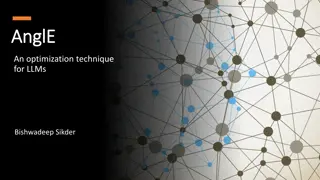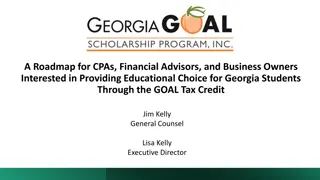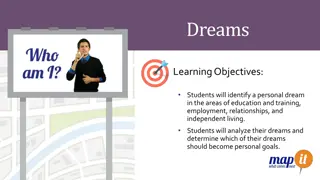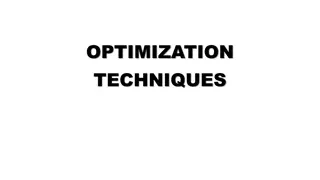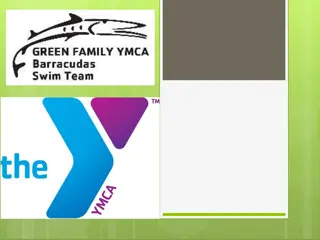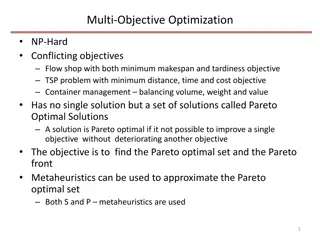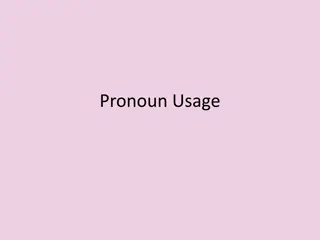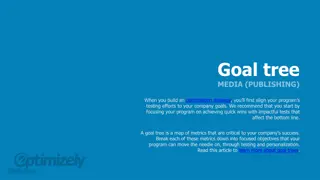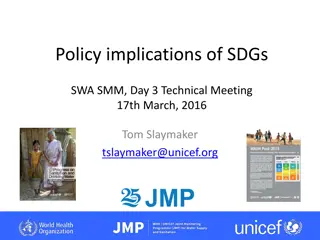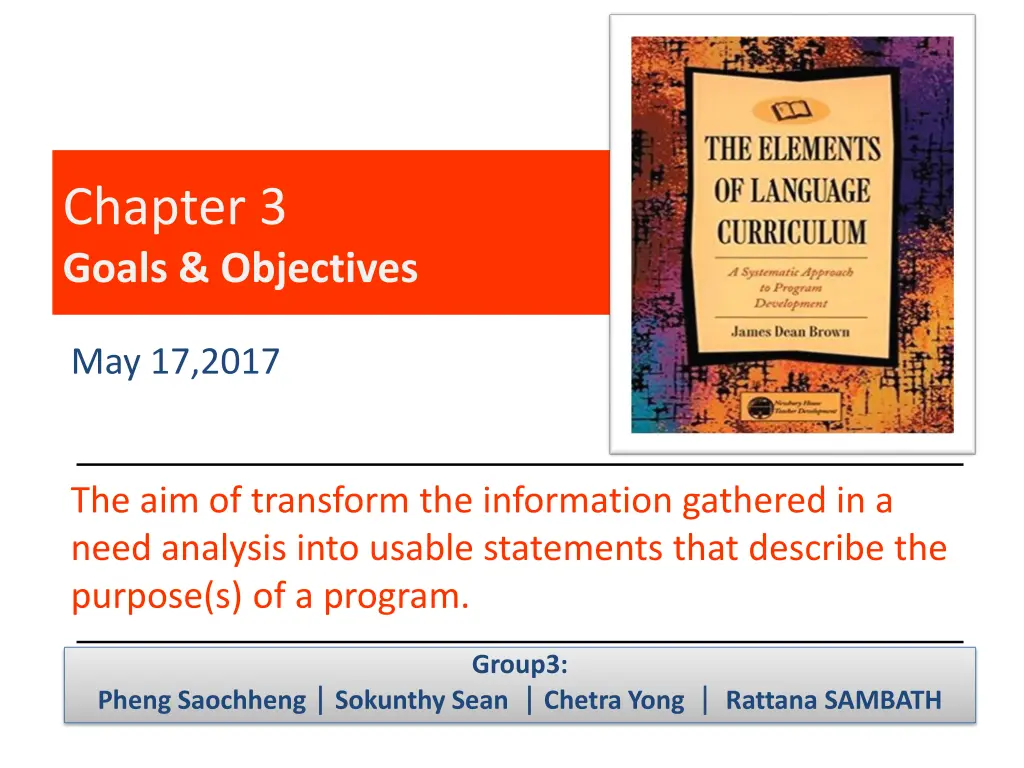
Formulating Program Goals and Objectives
Learn how to transform information from a needs analysis into program goals and objectives. Explore the concepts of goals and objectives in curriculum development. Understand the importance of clear and achievable program goals. Discover different types of goals in an English teaching program, such as language, situational, functional, structural, and attitudinal.
Download Presentation

Please find below an Image/Link to download the presentation.
The content on the website is provided AS IS for your information and personal use only. It may not be sold, licensed, or shared on other websites without obtaining consent from the author. If you encounter any issues during the download, it is possible that the publisher has removed the file from their server.
You are allowed to download the files provided on this website for personal or commercial use, subject to the condition that they are used lawfully. All files are the property of their respective owners.
The content on the website is provided AS IS for your information and personal use only. It may not be sold, licensed, or shared on other websites without obtaining consent from the author.
E N D
Presentation Transcript
Chapter 3 Goals & Objectives May 17,2017 The aim of transform the information gathered in a need analysis into usable statements that describe the purpose(s) of a program. Group3: Chetra Yong Pheng Saochheng Sokunthy Sean Rattana SAMBATH
Todays Talking 1. Goals and objectives, Chetra Yong 2. Formulation of Goals and Objectives, Rattana SAMBATH 3. Integrating Bloom Taxonomy in Formulating Goals and Objectives, Saochheng Pheng 4. Pros and Cons of Curriculum Objectives, Sokunthy Sean
1). Goals and objectives, Powered by: Mr. Chetra Yong
What are they? Goals Obj. Obj Obj. Obj. Obj.
Lead-in activities: 1.Supposed that you were a curriculum developer. You ve been hired to design a brand-new English teaching program. You ve just conducted needs analysis and having had lots of information from NA, so what you re gonna do next with this info. Needs Analysis can generate a great a mount of information that must be sorted and Used in some way within curriculum. One way to use this information is to apply what Has been learned in NA for the formulation of program goals and objectives Brown (1995, p. 71) Pair Discussion: 2. What do you think goals and objectives in general mean? 3. What do program goals (PG) and instructional objectives (IO) mean to you? 4. How do you distinguish PG from IO?
4 points should be remember when developing goals from perceived needs: 1. General statements of the program s purposes 2. Focus on what the program hopes to accomplish, and what the Students should be able to do when they leave the program Goals = 3. Serve as one basis for developing more precise and Observable objectives. 4. Should not be view as permanent, that is, they should never Become set in cement.
Goals may take many shapes: 1. Language and situational Ex: In our program, the students will learn how to fill out form in English, read a menu, and order a meal. 2. Functional Ex: The goal of our course is that the student will be able to converse in social English with the focus on greetings, rejoinders, and farewells. 3. Structural Ex: The center's aim is to help students learn and master English tenses. 4. Attitudes and feelings promoted Ex: The program foster acceptance of cultural differences between countries. So What is exactly goal in this context? General statements of the desirable and attainable curriculum purposes and aims based on the perceived language and situation needs of the participants in a program.
What is an objective/instructional objective? A specific statement describing the particular knowledge, behavior and/or skills that the learner will be expected to know or perform at the end of the program or course. Statements about how the goal will be achieved. By achieving the objectives, the goal will be reached. (J. D. Brown 1995, p. 76).
Cause and effect relationship between goals and objectives Obj. Obj. Obj. GOALS Obj. Obj. THEN THIS GOAL WILL BE REACHED IF THESE OBJECTIVES ARE ACHIVED
Able to identify the basic usages Able to apply regular verbs to different person subjects Able to use V+ - es, -ies Use present simple Able to identify sub. He/She/It and their reference
For every general goal, there are multiple specific goals. Goal 3 Goal 1 Goal 2 1 3 3 1 2 2 1 3 2
What is different between goals and objectives? Goal: 1) quite lengthy and so general in content 2) statement is closer to a very general goal Objective: very specific end of a continuum and three essential characteristics indicated by Mager (1975,p.23) (Performance, Conditions, and Criterion)
Exercise: Use the below need to write a goal and objectives: 1. The result of NA conducted by Chetra: This group of students needs to be able to use basic vocabulary and structure for simple communication. 2. Goal should be: . 3. Objectives should be: ... ... . .
2).Formulating Goals and Objectives Powered by: Ms. Rattana SAMBATH 1.
Talking Points 1.Benefits of Clear Goal and Objectives 2.How to formulate or articulate with different Model 3.Sample of Goal and Objectives and reflection
Benefits of Clear Goal and Objectives Helps us see how a class fits in the curriculum Explains what the learners will get from a course Provides clearly support on - materials - methodology - activities/ process
Benefits of Clear Goal and Objectives Provides a map for assessment Goals provide guidelines and should be flexible to change, if they are not appropriate. Clear goals help to make teaching purposeful because what you do in class is related to your overall purpose.
cont GOALS Should keep in mind the audience for the goals. Describe the problem/need to be addressed and how it will be accomplished through instruction. What components will be covered, What the learner will be able to perform. Must consider context constraints Should be achievable Should measure how successful a course has been
Benefit of OBJECTIVES Guide the development of the lesson. Help potential users determine lesson appropriateness. Give the learner to focus on important learning tasks. Define the evaluation of learner performance. Can be used to evaluate the success of the lesson.
Formulating Goals and objectives Formulating goals and objectives helps to build a clear vision of what you will teach or disserved results Communicate proposes what you want your Audience/ Participant/ Students achieve and it outlines how to make them clear ways or process to reach.
By Mager (1975, p.23) Three essential components for objective setting - Performance (what the learner will be able to do) - Conditions (important conditions under which the performance is expected to occur) - Criterion ( the quality or level of performance that will be considered acceptable)
Example By the end of the course, a student will be able to : prepare a term paper (including footnotes, bibliography, title page and so forth), take notes on a lecture, answer question following such a talk. By the end of the course the students will be able to identify implicit relationship in academic English between parts of a concepts in a flow chart, in a table and in an outline, as well as in the prose describing a chart or table and in an essay. By the end of the course, the students will be able to write the full forms of selected abbreviations drawn from pages 6-8 of the course take book with 80 percent accuracy.
FORMULATING AND ARTICULATING GOALS organize your goals choosing a framework: KASA: Knowledge, Awareness, Skills, Attitudes (developed by faculty in department of language teacher education at school international training) ATASK: Awareness, Teacher, Attitude, Skills, and Knowledge (David thomson) Language goals, Strategic Goals, Philosophical goals, and method or process goals (Genesse and Upshur, 1996)
Cumulative Framework for Objectives Coverage: material, textbook units, topics, etc. Activity: what the students will do with the material Involvement: how learners will interact with the material (activities) Mastery: what learners will do after a given class or activity Generic thinking objectives (or critical thinking objectives Graves, 2000) describe the meta-cognitive Saphier and Gower s (1987)
3). Integrating Bloom Taxonomy in Formulating Goals and Objectives Powered by: Mr. Pheng Saochheng
Who is BENJAMIN BLOOM? BENJAMIN SAMUEL BLOOM - was a Jewish-American educational psychologist. Contributions: 1. Classification of Educational Objectives 2. Theory of Mastery-Learning
THREE DOMAINS OF LEARNING Cognitive Domain (Knowing/Head) Mental Skills (KNOWLEDGE= Think) Psychomotor Domain (Doing/Hands) Manual or physical skills (SKILLS= Do) Affective Domain (Feeling/Heart) Growth in feelings or emotional areas (ATTITUDE= Feel)
ASK: ATTITUDE, SKILL AND KNOWLEDGE PSYCHOMOTOR DOMAIN Skill/Do(Physical skills) COGNITIVE DOMAIN Knowledge/Think AFFECTIVE DOMAIN Attitude/Feel 1.Knowledge(recall and memorize) 2.Comprehension (understand) 3. Application (Apply & use) 4. Analysis(structure& elements) 5.Synthesis(create &build) 6.Evaluation(assess, judge in relation term) 1. Imitation (copy) 2. Manipulation (follow instruction) 3. Develop Precision 4. Articulation ( combine, integrate related skill) 5.Naturalization (Automate, become expert) 1.Receiving (Awareness) 2.Responding(React) 3.Valuing( Understand &Act) 4.Organization (organize personal value system) 5.Characterization (adopt and behavior) Bloom, B (1956) Taxonomy of Educational Objectives Book 1: Cognitive Domain New York: Longman
ORIGINAL TAXONOMY (1956) ---> REVISED TAXONOMY (2001) Remember (I know) Understand (I comprehend) Apply (I can use it) Analyze (I can be logical) Evaluate (I can judge) Create ( I can plan) Knowledge Comprehension Analysis Application Synthesis Evaluation
Two domains in language teaching by H.D Brown(1965) Cognitive domain( Language Goal) referred to Language Knowledge and Language Skills the student will be learning in the program. Affective domain( Affective Goal) referred to aspects of learning related to feelings, emotions, degree of acceptance, values, biases, and so forth.
How integrate Bloom in formulation goal and objective? Lesson objective must be in the 2 or 3 domains- Knowledge(cognitive), Skill(Psychomoto),Attitude/Value (Affective) Follow the principle of SMART Goals and Objectives
How integrate Bloom in formulation goal and objective? Example: GOAL: By the end of the lesson, students will be able to identify and use American slang terms and phrases OBJECTIVE 1(Cognitive ): Students will identify and list 5 slang terms they have heard from their peers. OBJECTIVE 2(Affective):Student will choose 3 of the most offensive slang terms from a list developed by the entire class. OBJECTIVE 3(Psychomotor/Physical:): Students will create expressive gestures to go with their favorite slang terms.
Cognitive Domain, Active Verbs for Objectives Knowledge Comprehension Application Analysis Synthesis Evaluation Describe Define Identify List Name Recognize Reproduce State Outline Match Label Articulate Distinguish Estimate Explain Generalize Infer Interpret Paraphrase Rewrite Summarize Translate Covert Defend Apply Change Construct Compute Discover Demonstrate Modify Operate Predict Prepare Produce Show Solve Use Analyze Categorize Compare Contrast Differentiate Discriminate Identify Illustrate Infer Outline Point out Relate Select Separate Subdivide Compile Create Design Diagnose Diagram Discriminate Explain Generate Modify Organize Plan Relate Reorganize Revise Tell Write Appraise Assess Compare Conclude Contrast Criticize Critique Describe Evaluate Explain Interpret Justify Summarize Support
Psychomotor Domain, Action Verbs for Objectives Imitation Manipulation Precision Articulation Naturalization Attend Attempt Ask Answer Carry out Copy Follow Repeat Confidence Participate Tell Try Give Example Express Observe Organize Acquire Assemble Complete Demonstrate Replicate Share Point out Break down Put Together Arrange Advance Achieve Choose Conduct Construct Design Exceed Integrate Organize Perform Modify Master Refine Mixes Respond Vary Adapt Alter Change Conduct Construct Design Integrate Organize Perform Transcend Modify Refine Reorganize Mixes Arrange Build Combine Compose Construct Create Design Initiate Make Originate
AffectiveDomain, Action Verbs for Objectives Receive Respond Value Organize Characterize Acknowledge Ask Attend Choose Describe Follow Give Hold Identify Listen Name Receive Select Tolerate Use View Watch Answer Assist Communicate Conform Comply Consent Contribute Cooperate Discuss Follow up Help Indicate Inquire Participate Present Question React Read Reply Recite Accept Adopt Approve Choose Commit Complete Desire Differentiate Form Initiate Justify Join Propose Prefer Sanction Report Endorse Exhibit Express Explain Adapt Adhere Alter Arrange Categorize Classify Combine Complete Defend Formulate Establish Generalize Integrate Identify Modify Prepare Rank Rate Act Advocate Behave Characterize Conform Continue Defend Disclose Discriminate Display Encourage Endure Exemplify Influence Preserve Perform Practice Uphold Retain Solve
Examples: Course Syllabus of TESOL 2002 Expected Learning Outcomes By the end of the course, learners should gain the following knowledge: the basic vocabulary and concepts in research methodology and understanding about types of methods to be used for collecting data in quantitative study; understanding about different research designs such as experimental design, quasi-experimental design, and non-experimental design; knowledge about statistical methods necessary for quantitative data analysis using SPSS including chi-square, t-test, correlation, multiple regressions and ANOVA
Example: Course Syllabus of MA.TESOL By the end of the course, learners should be able to use the following skills: applying the research methods for selecting samples and collecting data, and accurately using a proper statistical tool for their quantitative research; analyzing quantitative data using SPSS including chi-square, t-test, correlation, multiple regressions and ANOVA; evaluating an appropriate research paradigm to be used for their research study for their master s thesis; creating a research proposal using an appropriate research design. By the end of the course, learners should develop the following attitudes: developing their positive attitude toward research to contribute to the advancement of knowledge; becoming curious in their field of expertise to enhance their knowledge through research.
To sum up 1. Who is Bloom and what are the THREE DOMAINS OF BLOOM TAXONOMY ? 2. Original Bloom Taxonomy (1956) and Modified Bloom Taxonomy (2001) 3. Two domains in language teaching by H.D Brown(1965), Cognitive & Affective domain 4. Principles to integrate Bloom Taxonomy to formulate GOALS and OBJECTIVE 5. Common Verbs using in 3 Domains of Bloom Taxonomy
References http://www.alps-cetl.ac.uk/litebite/litebiteLearningAimsObjectives/page_03.htm http://www.businessballs.com/bloomstaxonomyoflearningdomains.htm https://www.clinton.edu/curriculumcommittee/listofmeasurableverbs.cxml http://thesecondprinciple.com/instructional-design/writing-curriculum/
4. Pros and Cons of Curriculum Objectives Powered by: Mr. Sokunthy Sean
Pros: 5 battle lines are quickly drawn 1. Association with behavioral psychology 2. Issues with quantify ability 3. Trivialization of instruction 4. Limitations in teachers freedom 5. Inadequacy for expression of language learning
Cons: Benefits of using objectives Objectives help teachers to: Convert the perceived needs into teaching points. Clarify and organize those teaching points. Think through skills and sub-skills underlying instructional points. Decide what they want students to be able to do. Decide the level of specificity for teaching activities.
Cons: Benefits of using objectives Objectives help teachers to: Construct valid and reliable assessment tools (see chapter 4) Adopt, adapt and develop teaching materials (see chapter 5) Develop professionally (see chapter 6) Evaluate students progress and program effectiveness (see chapter 7) Be part of the collective process of curriculum development.
Conclusion Objectives view as: - flexible; - temporary; - and revisable. Objectives can be creative. Without goals and objectives, a program may have no clear purpose and direction.

